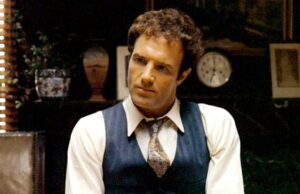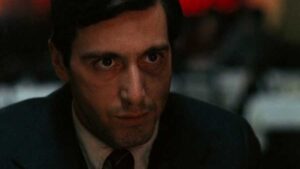by James Scott Bell
@jamesscottbell
 We lost James Caan this past week. It seems an apt time to take a look at the movie that made him a star, Francis Ford Coppola’s The Godfather (1972) from the novel by Mario Puzo. I’ll be concentrating on the movie, but a good exercise is to compare a book to its film version. Usually people end up saying a book is “better” than the film. In this case, however, it’s the other way around.
We lost James Caan this past week. It seems an apt time to take a look at the movie that made him a star, Francis Ford Coppola’s The Godfather (1972) from the novel by Mario Puzo. I’ll be concentrating on the movie, but a good exercise is to compare a book to its film version. Usually people end up saying a book is “better” than the film. In this case, however, it’s the other way around.
The Godfather is currently listed by AFI as the second-greatest movie of all time (behind Citizen Kane). It’s a graduate course in acting. Caan holds his own alongside Brando, Pacino, and Robert Duvall. He proved that the acting chops he showed in the TV movie Brian’s Song (1971) were legit. Brando won the Oscar as Best Actor. Caan, Pacino, and Duvall all got Supporting Actor nods (the winner was Joel Grey in Cabaret).
Caan went on to a long and successful career. And what writer escaped the chills—or maybe a few nightmares—when Caan was “cared for” by his “number one fan” in Misery? (Please don’t ever use the word hobbling around me. Thanks.)

James Caan as Sonny Corleone
Back to The Godfather. The story lessons from this movie could fill a book. Since this is a blog, I’ll limit myself to a few I find particularly instructive.
The Plot
When the aging don of the Corleone crime family refuses to give aid to a new narcotics business, his enemy seeks to kill him. His son Michael, a war hero, avenges the attempted assassination by killing a mobster and a corrupt police captain. In the crime wars that follow, Michael rises to become the most ruthless godfather of all.
Lesson: Be able to summarize your plots in three sentences (known as the Elevator Pitch). This applies as much to epic fantasy as it does category romance. My formula for the Elevator Pitch is as follows (using The Insider by Reece Hirsch as an example):
- (Character name) is a (vocation) who (immediate goal or desire)
Will Connelly is a lawyer on the verge of realizing his dream of becoming a partner at a prestigious San Francisco firm.
- But when (doorway of no return), (Character) is (main confrontation)
But when Will celebrates by picking up a Russian woman at a club, he finds himself at the mercy of a ring of small-time Russian mobsters with designs on a top-secret NSA computer chip Will’s client has created.
- Now (Character) must (main objective)
Now, with the Russians mob, the SEC and the Department of Justice all after him, Will has to find a way to save his professional life and his own skin before everything blows up around him.
Argument Against Transformation
A simple and elegant tool for character arcs is what I call “The Argument Against Transformation.”
Usually, at the end of a classic Hero’s Journey, the Lead is transformed into a “better self” than at the beginning. Rick in Casablanca becomes a hero willing to sacrifice his personal happiness for a greater good. He puts his true love, Ilsa, on the plane with her husband, Victor Lazlo, because he knows it’s best for everyone and even the war effort.
But what’s his philosophy early in Act 1? It’s his argument against such a transformation. “I stick my neck out for nobody,” he says.
This gives the audience an early hook, a hint at what the story is really about.
In The Godfather, we have a negative arc, a transformation that goes the other way.
During the wedding scene at the beginning of the film, Michael (who will turn out to be the main protagonist) is a war hero. He’s sitting with his girl, Kay, when she spots a “scary man.” Michael explains that is Luca Brasi, who is a “friend” of his father’s. He tells her about an incident where Vito and Luca paid a visit to a band leader who was unwilling release singer Johnny Fontaine from a long-term contract. Luca, Michael explains, put a gun to the band leader’s head as Vito tells him to sign the release, or his brains will end up all over it.
Kay is duly shocked. But Michael assures her, “That’s my family, Kay. It’s not me.” That’s his argument against his (negative) transformation.
Proving the Transformation
At the end of a film or novel, we must see something that proves the transformation. Usually this is the last scene or chapter. In Casablanca, Rick proves he is a sacrificial hero by literally putting his life on the line to save Ilsa and Lazlo.
In the last scene of The Godfather, Michael’s sister, Connie, screams hysterically at Michael for ordering the hit on her husband, Carlo. Kay hears it all, and when she is alone with Michael she asks him if it’s true. “Don’t ask me about my business, Kay,” he says. She is insistent. “Enough!” he says. Then accedes: “This one time I’ll let you ask me about my affairs.”
Kay asks again, and in a most sincere voice Michael looks into the eyes of his wife and says, “No.”
There’s the transformation. Michael has forfeited his soul to become the new don. He can lie to his wife’s face without a single qualm.
See for yourself, and note the memorable visual at the very end:
Lesson: Look at what your Lead character has become at the end of your novel. Give the Lead a line of dialogue in Act 1 that expresses the opposite view. At the end, show us in a scene how the Lead has changed, thus proving the transformation.
Mirror Moment
In the dead center of the movie is the Mirror Moment for the protagonist, Michael. (For a full treatment of this beat, see my book Write Your Novel From the Middle).
In brief, the Lead has a moment within a scene where he has to metaphorically look at himself, as if in a mirror (though it’s funny how often in a movie there’s a literal mirror in the scene). The character has to take personal stock right in the middle of the “death stakes” of Act II. This moment is the linchpin between the argument against transformation at the beginning, and proving the transformation at the end.
After Michael thwarts another attempt on his father’s life, at the hospital, he’s confronted by the corrupt police captain, McCluskey, who proceeds to break Michael’s face.
In a family meeting that follows, Sonny is ready to go to war. Tom Hagen counsels against it.
Michael, sitting there virtually ignored, suggests a plan—they’ll set up a meeting with Sollozzo and McCluskey, where Michael (who is considered by the enemies to be neutral) will get his hands on a gun and kill them both.
The meeting is set at a little restaurant in the Bronx. Offscreen, the caporegime Clemenza plants a gun in the bathroom. The plan is for Michael to ask to use the john, get the gun, come out and immediately shoot both men, then drop the gun and walk out.
Michael has a mirror moment before the shooting. That moment in the book is rendered:
Sollozzo began talking again in Italian, but Michael couldn’t understand a word. He wasn’t listening. All he could hear was the sound of his heart, the thunder of blood between his ears.

Al Pacino as Michael Corleone
It is more pronounced in the movie. Michael does not follow Clemenza’s instructions coming out of the bathroom. Instead of shooting the men, he sits back down at the table. Sollozzo talks, but the camera stays on Michael’s face. He’s clearly contemplating what’s about to happen. Once he kills a New York police captain, his life will never be the same. No more honored war hero. No more avoiding “the family business.”
He shoots them.
The rest of the movie revolves around the question of whether Michael will return to his “former self” and guide the family to legitimacy, or continue his trajectory toward ruthless mafia don.
Lesson: Whether you plan or “pants” or something in between, at some point brainstorm possible mirror moments for your Lead. Since I started doing this myself, I’ve found that the fourth or fifth idea on my list is usually the one that jumps out at me and announces, “This is what your book is really all about, pal!”
Orchestrating the Cast
The principle of orchestration is so important. It simply means giving your characters distinct and contrasting personalities, tags, quirks. The more skillfully you do that, the more possibilities for conflict, in scenes and dialogue. That holds true not only for adversaries, but allies as well.
In The Godfather we have the three sons of Vito Corleone. Sonny is a bloodthirsty hothead; Fredo is weak and insecure; Michael is the smart one, and cool under pressure. While they are ostensibly on “the same side,” they also have conflict with one another.
Tom Hagen is the German-Irish lawyer among all the Sicilians. Thus he and Sonny get into some heated arguments. At one point Sonny screams at him, “If I had a war-time consiglieri, a Sicilian, I wouldn’t be in this shape!”
The two caporegimes, Tessio and Clemenza, are different in both physical form and personality. The jolly Clemenza shows Michael his “trick” for cooking for twenty guys. Sonny tells him to knock it off.
Among the secondary characters is the scary Luca Brasi. He is a stone-cold hit man. Just looking at him gives you the chills. But when he goes in to see Don Corleone on the day of Connie’s wedding, he is like a little boy, barely able to talk.
Lesson: Give all your characters, even the minor ones, physical and personality differences—and quirks. Do that, and the plotting of a novel almost takes care of itself.
Whew. That’s enough for today. If you’ve never seen The Godfather or The Godfather, Part II, you’re in for a treat. The acting is brilliant throughout. Of coruse, Brando dominates. My first “real” job was ushering in movie theater the summer of Godfather I. So I must have seen the movie, in bits and pieces, about twenty times. I watched Brando through a microscope, trying to “catch” him acting. Never did. He may just be the greatest actor of all time.
Comments welcome.

Excellent article and insights. We see the change in Michael when he tells Tom and Sonny that he will do the killing and then the loss of his soul when he does. Yet we root for him. That’s great storytelling.
Hi Doug. You bring up an important point about crime fiction. When the characters are all “bad guys” we can still root for the one bad guy who has a just cause (as defined by the crime world, not the law) against the other bad guys. Like in Richard Stark’s Parker series.
Useful piece. Donkey’s years since I watched The Godfather. I’ll have to do a re-run. Thanks 😊
Thanks for the story lessons from The Godfather. Wonderful! I’m eager to rewatch the movie. It’s good to see the lessons applied in a story with a negative arc.
Steve, The Godfather is one of those movies that gets better with each viewing. Enjoy!
Terrific deconstruction, Jim. I finally saw this movie for the first time about ten years ago on DVD. Especially good point about the orchestration of the cast. I still need to see “Godfather II.”
Have a wonderful Sunday!
G II is another masterpiece, Dale. I make special note of the tremendous acting of John Cazale as Fredo in this one, the mix of pity and sympathy he evokes.
A coworker recently told me he’d never seen The Godfather. After several minutes of bewilderment as to how a 40-year-old American man had not seen this film, I told him how jealous I was of him getting to now experience it for the first time.
Your final lesson hit me the hardest. I find that when I invest in making even minor characters unique and colorful, it helps my pantsing process immensely because I sort of become a method actor and think how each character would naturally react.
Ack! I went to a steakhouse about a year ago and for some reason the subject of movies was being bandied about at our table. I asked the young server, probably mid 20s, if she had ever seen The Godfather. She asked who was in it. I said Marlon Brando.
Drum roll…
She’d never heard of Brando.
Thanks for great story-telling lessons about an excellent movie. The last scene of The Godfather is a masterpiece in itself.
With your insights in mind, I look forward to watching the movie again. And you’ve given me plenty to think about as I continue grappling with my WIP.
That’s what we do here at TKZ!
I always appreciate your movie deconstructions, Jim. Somehow, the vague concepts we writers grapple with become easy and clear to understand when seen visually in a movie scene.
Thanks for talking about the negative character arc. That’s really helpful for building an antagonist who becomes a villain. My WIP has a prison administrator who takes pride in doing a good job until an inmate is killed on his watch and he must cover up the crime.
I like that set up, Debbie. Negative arcs make for great drama. The Greeks sure knew that!
Never saw any of the Godfathers, but I love Casablanca.
I am your movie dating service, Cynthia. You may just fall in love with The Godfather. Arrange a meeting!
Another piece of TKZ gold, Jim! Your analysis is spot-on, even to a newbie.
We own all three Godfather movies and have watched them multiple times. They are my all-time favorite movies because of the complexity of the characters.
I noticed something the last time. Even secondary characters can be given a mirror moment, right?
However, maybe the following isn’t exactly a mirror moment because it’s almost at the end of the movie.
Prior to the opera scene where Michael’s daughter is gunned down, Connie Corleone gives the poisoned cannoli to Don Altobello (Eli Wallach), her close friend.
Then she looks through the opera glasses and watches him eat it and die. The look on Connie’s face said it all. She’d stepped over the line (again) just like Michael.
Happy Sunday!
Good analysis, Deb. You’ve got a handle on this.
I didn’t know James Caan died. What a shame. Superb actor.
I’m writing a reversal in my WIP, so I was especially interested in your insights. What I initially struggled with was giving my MC a good enough reason to change sides, so to speak, but I finally found the one thing that would force her over the edge. Thank you for confirming reversals work, Jim. Hope you enjoying your Sunday!
Gotta love those breakthroughs, Sue. Cool!
Great post, Jim. Have you seen The Offer on Paramount+ about the making of The Godfather? Highly recommend it.
Not yet, but I’ve heard good things. Thanks for the nudge.
Always like the lessons you teach on writing and delving into a character’s inner core. I’ve seen pieces of The Godfather movies over the years. The actors all played their parts so well it was impossable to see them as “acting” and not the real thing. Guess that says it all.
Yes, truly a Hall of Fame cast. Credit Coppola’s direction, too.
Great, deconstruct! Seeing the mirror moment in a movie helps to make it concrete. I’ve watched The Godfather a couple of times but never got to see Godfather II. Will have to remedy that. Thanks for the lesson.
You’re in for an epic treat, Patricia.
Awesome. Thanks.